

Les engrais vert. Order Fabales. Abrus precatorius L.
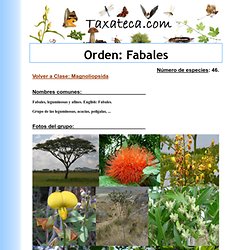
Syn: Glycine abrus. 2005. Africa, Ghana, close to Lake Volta. Leg: unknow collector. Sample donated by Fermín Poveda Aznar. Domain: Eukaryota. Esta planta es nativa de las montañas de India e Indochina, pero actualmente se distribuye por todas las regiones tropicales del planeta. Es una liana trepadora y perenne que alcanza los 5 metros de longitud. Imágenes obtenidas en: y Acacia cornigera (L.) 21-Oct-2006. Det: Carlos Galan Boluda. Dominio: Eukaryota. Esta acacia es un árbol nativo de Centroamérica, siendo llamativa por las grandes espinas que posee. Acacia glaucoptera Benth. Agosto-2006.
Canavalia o Pallar del Gentil - Canavalia ensiformis. Esta planta leguminosa es originaria de América tropical y se cultiva en el Perú en costa, sierra y selva hasta los 1,800 msnm.

Este vegetal sirvió de alimento a las culturas prehispánicas de la costa, ello se evidencia en el hallazgo de semillas, encontradas en fardos funerarios Paracas y en sitios arqueológicos del valle del río Chillón. Nombre científico: Canavalia ensiformis Familia: Fabáceas.Nombres comunes: Pallar del gentil, frejolón. Descripción botánica:Es un arbusto anual semierecto que alcanza una altura de 1. 20 m. Tallo corto y grueso con muchas ramas. Techniques agricoles de demain. Green Manure Seeds - The Finest Seeds & Advice. Lathyrus sativus. La almorta, chícharo, guija, pito o tito (Lathyrus sativus) es una especie perteneciente a la familia de las Leguminosas (Fabáceas), conocida en el ámbito mediterráneo, y también en Asia y África.

Denominaciones[editar] El nombre científico de esta planta es Lathyrus sativus y su nombre común, dependiendo del sitio, son los de almorta, alverjón, arveja, arvejo cantudo, arvejote, bichas, cantuda, cicércula, chícharo, diente de muerto, fríjol de yerba, garbanzo de yerba, guija, muela, pedruelo, pinsol, pito o tito. Existe un grabado de Goya en su visión "Desastres de la Guerra" con el nombre de: "Gracias a la Almorta". Usos[editar] Almortas tostadas. Tiene usos gastronómicos. Taxonomía[editar] Lathyrus sativus fue descrita por Carolus Linnaeus y publicado en Species Plantarum 2: 730. 1753.[3] Lathyrus asiaticus (Zalkind) Kudr.Lathyrus sativas L.Lathyrus sativus subsp. asiaticus Zalkind[4]
ECHO - Underutilized Food Plants - Winged Bean Selections. Arachis pintoi. El maní forrajero (Arachis pintoi), se usa como alimento complementario en aves criollas.
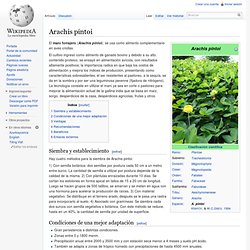
El cultivo ingresó como alimento de ganado bovino y debido a su alto contenido proteico, se ensayó en alimentación avícola, con resultados altamente positivos; la importancia radica en que baja los costos de alimentación y mejora los índices de producción, presentando como características sobresalientes, el ser resistentes al pastoreo, a la sequía, se da en la sombra y por ser una leguminosa perenne (fijadora de nitrógeno). La tecnología consiste en utilizar el maní ya sea en corte o pastoreo para mejorar la alimentación actual de la gallina india que se basa en maíz, sorgo, desperdicios de la casa, desperdicios agrícolas, frutas y otros. Siembra y establecimiento[editar] Hay cuatro métodos para la siembra de Arachis pintoi: 1) Con semilla botánica: dos semillas por postura cada 50 cm a un metro entre surco.
Condiciones de una mejor adaptación[editar] Pest Repellant Plants, Nitrogen Fixing Plants, Improving The Health. I wonder how many of our readers realised that we missed out our April Newsletter.

I hope there weren't too many disappointed people. With the rain returning to our orchards again, the enthusiasm has flooded us and before I knew it April had dissappeared. To make up for the gap, I have added in a few extra articles to this months newsletter. I hope you enjoy it and I hope that you have received some of this fabulous Autumn weather. Prevention is better than cure. An integrated approach of healthy soils and healthy trees, preventative measures, including inter-planting with pest repelling and deterrent plants, good monitoring to nip the bug in the butt when they do come along and a few simple techniques to fall back on when the situation is looking dire, are essential items in your gardening tool bag.
A large selection of herbs, fragrant and flowering plants can assist with pest control in your orchard and garden. Aphids in your garden? Some of our native plants. Our new Exotic Fruits- Prairie Seeds. Arachis glabrata. Common names Rhizoma peanut (USA), creeping forage peanut (Australia).

Origin and geographic distribution Native to Brazil, Argentina and Paraguay between 13° S and 28° S. Introduced to Australia, the United States, India, Thailand, Malaysia and Indonesia. Description Herbaceous perennial with erect to decumbent unbranched stems with a deep, woody taproot and a dense mat of rhizomes. Uses A. glabrata is a high quality forage legume for intensively grazed pastures on infertile, acid soils. Season of growth. Achillée. Un article de Wikipédia, l'encyclopédie libre.
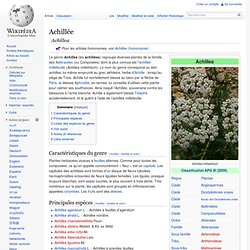
Le genre Achillea (les achillées) regroupe diverses plantes de la famille des Astéracées (ou Composées) dont la plus connue est l'achillée millefeuille (Achillea millefolium). Le nom du genre correspond au latin achillea, lui-même emprunté au grec akhileios, herbe d'Achille : lorsqu'au siège de Troie, Achille fut mortellement blessé au talon par la flèche de Pâris, la déesse Aphrodite, en larmes, lui conseilla d’utiliser cette plante pour calmer ses souffrances.
Ainsi naquit l’Achillée, souveraine contre les blessures à l’arme blanche. Achille a également blessé Télèphe accidentellement, et le guérit à l'aide de l'achillée millefeuille. Caractéristiques du genre[modifier | modifier le code] Principales espèces[modifier | modifier le code] Listes des espèces du genre[modifier | modifier le code] Selon Catalogue of Life (20 juin 2013)[1] : Voir aussi[modifier | modifier le code] Green Manure. Nitrogen-Fixers.pdf (Objet application/pdf) CTAHR Sustainable and Organic Agriculture Program. Cordite Country. Green manuring. Green manuring is the plowing under or soil incorporation of any green manure crops while they are green or soon after they flower.

Green manures are forage or leguminous crops that are grown for their leafy materials needed for soil conservation. Advantages of green manuring Improves the soil fertility Add nutrients and organic matters Improves the soil structure Improves soil aeration Helps control insect/mite pests, nematodes, and diseases Helps control weeds Promotes habitat for natural enemies Increases soil's biodiversity by stimulating the growth of beneficial microbes and other soil organisms Green manure crops Criteria for the selection of green manure crops Fast growing Produce abundant and succulent tops Well adapted to the local condition Can fix nitrogen in the soil Reminders Broadcast or sow the seeds after harvest Cut the greens after flowering and plow them under Sow or transplant the next crops 1-2 weeks after the incorporation of the green manure. Fixation de l'Azote. Arachis glabrata. Arachis glabrata (Creeping forage peanut, Rhizoma peanut, Rhizoma perennial peanut, Perennial forage peanut, Golden Glory, Ornamental Peanut Grass; Portuguese common names included Amendoim-forrageiro, Amendoim-bravo, Amendoim-do-campo-baixo) is a high quality forage plant native to Argentina, Brazil, and Paraguay vegetation.
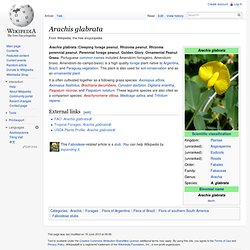
This plant is also used for soil conservation and as an ornamental plant. Engrais vert. Un article de Ékopédia, l'encyclopédie pratique.
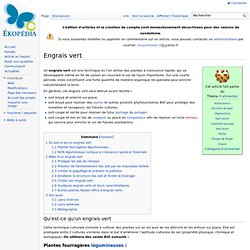
Un engrais vert est une technique où l'on utilise des plantes à croissance rapide, qui se développent même en fin de saison en couvrant le sol de façon importante. Sur une courte période, elles constituent une forte quantité de matière organique récupérable pour enrichir naturellement la terre. Grain & Seed Crops - Prairie Garden Seeds. – Most of my wheat collection is older varieties plus a couple of more recent ones that are recommended for wheat weaving. They generally grow 3’ — 5' tall and mature easily. They range from the Triticum monococcum varieties, which date back to the beginning of civilization, to the products of Canada's wheat breeding program this past century (with date of introduction in brackets following the name). Wheats are all very decorative but Utrecht Blue, the three Triticum monococcums, Polish, Vavilovii and Emmer would be especially attractive in dried arrangements.
If you are thinking of growing your own wheat for eating, Spelt, Emmer, Utrecht Blue, and Triticum monococcum are very difficult to thresh by hand. Each year I grow a part of my wheat collection at St. (Triticum aestivum) has always been the main wheat grown on the prairies. I also have small quantities of the following hard red spring wheats which were bred or grown in Canada.
(T. sphaerococcum) – Short and very upright.